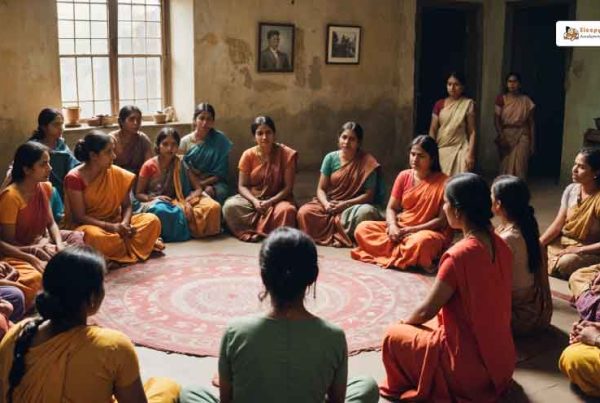In India, the gap between men and women in economic roles is a big issue. While some progress has been made, there is still a long way to go. Women have fewer chances to work and earn money compared to men. This article looks at the current state of gender equality in India’s economy, its impact, and what can be done to improve it.
Key Takeaways
- India has only reached 36.7% gender equality in economic participation.
- Closing the gender gap in employment could boost India’s GDP by 30%.
- India ranks low globally, with less than 40% gender parity in economic opportunities.
- Gender equality in India could add $700 billion to its GDP.
- Women in India spend much more time on unpaid care work compared to men.
Current State of Gender Parity in Economic Participation
Statistical Overview
India has made some progress in closing the gender gap in economic participation, achieving 64.3% parity. However, this still leaves a significant gap to be addressed. The country ranks near the bottom globally, with less than 40% parity in providing equal opportunities for men and women in the workforce.
Comparative Analysis with Other Countries
When compared to other nations, India’s performance is concerning. While the global average for gender parity in economic participation stands at 68.5%, India lags behind. This indicates that other countries are making strides in this area, while India has much more work to do.
Challenges Faced by Women in India
Women in India face numerous challenges that hinder their economic participation. These include societal norms, lack of access to education and skill development, and limited opportunities in the job market. Addressing these issues is crucial for improving gender parity in the country.
Impact of Gender Inequality on India’s Economy
GDP Growth Potential
Achieving gender equality in India could significantly boost the economy, potentially adding $700 billion to the GDP. Bridging the gender gap in employment alone might lead to a 30% increase in GDP. This highlights the immense economic potential that lies in ensuring equal participation of women in the workforce.
Sector-Specific Impacts
Gender inequality affects various sectors differently. For instance, in technology and finance, the lack of female participation limits innovation and growth. In agriculture, women often face barriers to land ownership and access to resources, which hampers productivity. Addressing these disparities can lead to sector-specific improvements and overall economic growth.
Long-Term Economic Consequences
The long-term consequences of gender inequality are profound. Reduced female participation in the economy leads to lower household incomes and increased poverty rates. Over time, this can result in a less educated workforce and slower economic development. By addressing gender inequality, India can ensure a more sustainable and inclusive economic future.
Gender equality is not just a social issue; it’s an economic imperative. Ensuring equal opportunities for women can unlock significant economic benefits for India.
Government Policies and Initiatives
Existing Policies
India has implemented several policies to promote gender equality in the workforce. These include the Maternity Benefit Act, which provides paid leave for new mothers, and the Equal Remuneration Act, which mandates equal pay for equal work. These policies aim to bridge the gender gap by ensuring women have the same opportunities as men.
Recent Initiatives
Recently, the government has launched initiatives like the “Beti Bachao, Beti Padhao” campaign to encourage the education and empowerment of girls. Another significant initiative is the “Mahila-E-Haat,” an online marketing platform to support women entrepreneurs. These steps are crucial in remedying the gender gap through fiscal, administrative, and regulatory measures.
Effectiveness and Criticisms
While these policies and initiatives are steps in the right direction, their effectiveness is often questioned. Critics argue that implementation is inconsistent and that more needs to be done to address deep-rooted societal norms. Additionally, there is a need for better monitoring and evaluation to ensure these policies achieve their intended outcomes.
The success of these initiatives largely depends on changing societal attitudes and perceptions towards women in the workforce.
Role of Education and Skill Development
Importance of Education
Education is a powerful tool for empowering Indian women through skill development. It opens doors to better job opportunities and helps in bridging the rural gender gap in skill development. When women are educated, they can contribute more effectively to the economy, leading to a more balanced and prosperous society.
Skill Development Programs
Skill development programs are essential for equipping women with the necessary skills to participate in the workforce. These programs focus on various areas such as technology, healthcare, and entrepreneurship. By providing targeted training, these initiatives help women gain confidence and improve their employability.
Barriers to Accessing Education
Despite the benefits, there are several barriers to accessing education for women in India. These include socio-cultural norms, financial constraints, and lack of infrastructure. Addressing these challenges requires concerted efforts from the government, private sector, and civil society to ensure that every woman has the opportunity to learn and grow.
Bridging the rural gender gap in skill development necessitates concerted efforts across multiple fronts. Policy interventions, financial support mechanisms, and community engagement are crucial to making education and skill development accessible to all women.
Corporate Sector’s Role in Bridging the Gap
Corporate Social Responsibility
The corporate sector in India has a significant role in eliminating gender disparities. Many companies are now focusing on Corporate Social Responsibility (CSR) initiatives that promote gender equality. These initiatives include mentorship programs, scholarships for women, and creating safe workplaces.
Women in Leadership
Women-led firms in India exhibit superior performance in terms of higher mean labor productivity than men-led firms. Despite this, women are still underrepresented in leadership roles. Encouraging more women to take on leadership positions can help bridge the gender gap and improve firm performance.
Workplace Policies and Practices
Implementing family-friendly workplace policies, such as flexible working hours and parental leave, can support women in balancing work and family responsibilities. Companies that adopt these practices often see higher employee satisfaction and retention rates.
The corporate sector’s commitment to gender equality is crucial for India’s economic growth. By fostering an inclusive work environment, companies can unlock the full potential of their workforce and contribute to the nation’s prosperity.
Societal and Cultural Factors
Traditional Gender Roles
In India, traditional gender roles are deeply rooted in society. These roles often dictate that men are the primary breadwinners while women are expected to manage the household. This gender inequality in India limits women’s opportunities for economic participation and personal growth.
Impact of Urbanization
Urbanization is gradually changing societal norms. As more people move to cities, there is a shift in attitudes towards gender roles. Women in urban areas have better access to education and employment opportunities, which helps in bridging the gender gap.
Changing Attitudes and Perceptions
There is a slow but noticeable change in attitudes and perceptions regarding gender roles. Younger generations are more open to gender equality and are challenging traditional norms. This shift is crucial for achieving long-term gender parity in India.
The journey towards gender equality in India is ongoing, but changing societal and cultural factors offer hope for a more balanced future.
Future Prospects and Recommendations
Policy Recommendations
To bridge the gender gap in economic participation, India needs to implement more inclusive policies. Bridging the gender gap in employment could potentially lead to a 30% increase in India’s GDP. This would significantly boost the economy and improve the quality of life for many families.
Role of Technology
Technology can play a crucial role in closing the gender gap. By providing women with access to digital tools and platforms, we can empower them to participate more actively in the economy. This includes online education, remote work opportunities, and digital financial services.
Global Best Practices
Learning from other countries can help India improve its gender parity. According to the World Economic Forum’s Gender Gap Report 2024, global gender parity stands at 68.5%, but progress is slow. India ranks 129th, showing a concerning performance. Adopting successful strategies from countries with higher gender parity can provide a roadmap for improvement.
The future of India’s economy depends on how well it can integrate women into the workforce. By focusing on education, technology, and inclusive policies, we can create a more equitable and prosperous society.
Conclusion
In conclusion, bridging the gender gap in economic participation is not just a matter of fairness but also a significant economic opportunity for India. Despite some progress, women still face many challenges in accessing the same opportunities as men. By working towards gender equality, India could see a substantial boost in its GDP, potentially adding up to $700 billion. This would not only improve the lives of women but also benefit the entire nation. It’s clear that achieving gender parity is crucial for India’s future prosperity.
Frequently Asked Questions
What is the current state of gender parity in economic participation in India?
India has closed about 64.3% of the overall gender gap. However, when it comes to economic participation and opportunity, the parity stands at less than 40%.
How does gender inequality impact India’s economy?
Gender inequality can hinder GDP growth. Bridging the gender gap in employment could boost India’s GDP by 30%.
What government policies exist to promote gender equality in India?
There are several policies aimed at promoting gender equality, including initiatives to improve women’s access to education and employment. However, their effectiveness varies.
Why is education important in bridging the gender gap?
Education equips women with the skills and knowledge needed to participate in the economy. It is a crucial factor in achieving gender equality.
How can the corporate sector help bridge the gender gap?
The corporate sector can play a significant role by implementing inclusive workplace policies, promoting women in leadership roles, and engaging in corporate social responsibility activities.
What are some barriers to achieving gender equality in India?
Barriers include traditional gender roles, limited access to education and skill development, and societal attitudes that discourage women’s participation in the workforce.






